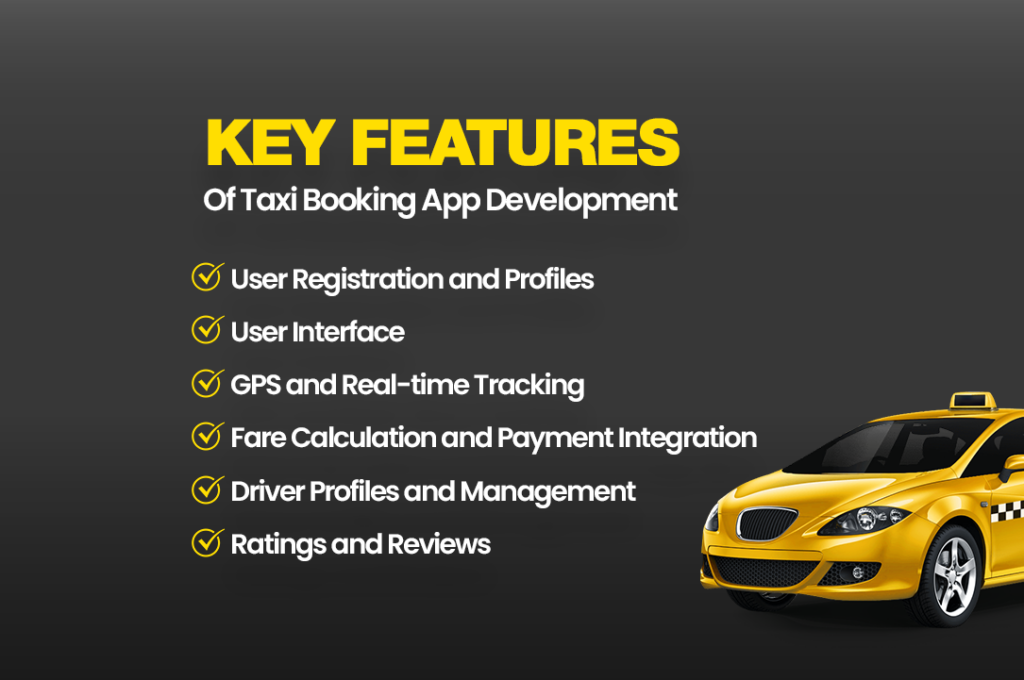Urban transportation has completely changed due to the market for taxi booking apps, which has improved accessibility, efficiency, and user-friendliness. This market has expanded exponentially over the past ten years, primarily due to rising smartphone usage and the need for dependable and practical transportation options. Large corporations such as Uber and Lyft have completely disrupted the taxi industry and paved the way for numerous other players across the globe.
The dynamic and ever-changing market has new service models and technological developments. The integration of innovative features such as real-time tracking, cashless transactions, ride-sharing options, and more has led to the growing popularity of these apps.

In 2021, it was projected that the global ride-hailing market, which includes taxi booking apps, would be valued at $85.8 billion. It is projected to reach $185.1 billion by 2026, growing at a 16.6% compound annual growth rate. This rise shows how popular and reliant these apps are on daily transportation.
Understanding the taxi booking app market requires identifying market trends and customer preferences and analyzing the business strategies and business plans of industry leaders like Uber and Lyft.
Analysis of Leading Taxi Booking Apps
Uber: As a trailblazer in the ride-hailing space, Uber has raised the bar for app usability and functionality. Uber’s success can be attributed to its robust platform, a wide range of service offerings (such as UberX, UberPOOL, and UberBLACK), and commitment to user safety and dependability. Uber is currently available in over 10,000 cities across 69 countries. Uber’s dynamic pricing model, or surge pricing, modifies fares in response to current supply and demand conditions. The tactic has drawn praise for its effectiveness and criticism for incurring high costs during peak hours.
Lyft: Known for its approachable and community-focused brand image, Lyft is a ride-hailing service that operates mainly in the United States and Canada. Though Lyft and Uber are similar in many ways, Lyft sets itself apart with initiatives like Lyft Pink, a subscription service with discounts, and its dedication to carbon neutrality. Lyft has also investigated driverless car technology and collaborated with tech firms to promote this emerging mobility solution.
Market Trends
Riding-Sharing Demand Is Growing
Ride-sharing is becoming increasingly popular due to its affordability and convenience, as more people choose shared rides to cut costs and lessen their environmental effects.
Emphasis on Safety and Hygiene
Since the pandemic, taxi booking apps have focused more on safety and hygiene. Contactless payments, mask recognition technology, and in-app health checklists are features quickly becoming standard.
Sustainability Initiatives
Using environmentally friendly transportation options is becoming increasingly popular. To cut carbon emissions, businesses are putting more money into electric cars and encouraging carpooling.
Integration of Advanced Technologies
Improving operational efficiency and user experience increasingly depends on artificial intelligence (AI), machine learning for route optimization, and predictive analytics for demand forecasting.
Extension of Services
To reach a wider audience, many taxi booking apps are expanding their offerings to include financial services, food delivery, and freight transportation.
Consumer Preferences
The market for taxi booking apps is dynamic, and its future is shaped by changing consumer preferences and technological advancements. In this cutthroat environment, businesses that can adjust to these changes while upholding high service standards will likely prosper.
- Convenience and Speed: Users’ top priorities are minimal wait times and speedy booking.
- Pricing Transparency: Consumers prefer clear information about fares and dislike surge pricing during peak hours.
- Safety Features: Features essential to user trust include emergency buttons, ride tracking, and background checks on drivers.
- Service Quality: Well-maintained cars with courteous, experienced drivers significantly impact customer satisfaction.
- Loyalty Programs: Discounts and prizes for regular users motivate them to keep using the app.
Core Features of a Taxi Booking App

A taxi booking app’s primary features are critical in determining its overall usability, effectiveness, and user experience. Here’s a closer look at these crucial elements:
User Registration and Profiles
Functionality: Enables users to set up and maintain accounts via social media integrations, phone numbers, or email addresses.
Importance: By enabling features like ride history, saved addresses, and preference settings, personalized profiles improve user experience.
Taxi Booking Interface
Functionality: An easy-to-use interface lets users select the type of ride, enter their pickup and drop-off locations, and view estimated fares.
Importance: A key element in user retention is how simple it is to make reservations. A smooth interface guarantees an easy booking process.
GPS and Real-time Tracking
Functionality: GPS technology makes real-time taxi tracking from reservation to destination possible.
Importance: This feature improves user safety and trust by enabling users to track their rides and share their real-time locations with others.
Fare Calculation and Payment Integration
Functionality: Automatic fare computation according to service type, time, and distance. Integration for cashless transactions with a range of payment gateways.
Importance: The ease and dependability of the service are increased by transparent fare calculation and various payment methods, including credit/debit cards and e-wallets.
Driver Profiles and Management
Functionality: Driver profiles with information such as identification numbers, photographs, vehicle specifications, and evaluations. A system for the backend that oversees driver documentation, compensation, and performance.
Importance: Ensures safety and reliability by providing users with driver information. Facilitates the maintenance of service quality and efficiently managing the driver workforce.
Ratings and Reviews
Functionality: Enables passengers to assess their ride encounters and offer input regarding the driver’s conduct.
Importance: Reviews and ratings are very important for keeping service quality high. They explain how well drivers do and help other users make intelligent choices.
A taxi booking app’s fundamental functions are to ensure it satisfies users’ requirements and offers a reliable, effective, and user-friendly service. Maintaining competitiveness in the rapidly evolving ride-hailing industry necessitates constant enhancements and modifications.
Advanced Features and Technologies
A taxi booking app must have advanced features and technologies to compete and provide a great user experience. The following is a summary of some essential advanced features:
Route optimization using AI and machine learning
Functionality: Utilizes artificial intelligence (AI) and machine learning algorithms to analyze traffic patterns, road conditions, and the most efficient real-time routes.
Importance: This technology ensures faster and more efficient trips, reducing wait times for passengers and idle times for drivers. It also helps predict demand in different areas, enabling better allocation of vehicles.
Including Safety Features
Functionality: Includes features like SOS buttons, ride-sharing with trusted contacts, real-time location tracking, and background checks for drivers.
Importance: Safety features are crucial for building trust and ensuring the security of both passengers and drivers. They are essential for reassuring users who might be hesitant about ride-hailing services.
Conversation and Chat within the App
Functionality: Allows communication between drivers and passengers within the app without disclosing personal contact details.
Importance: Enhances privacy and security. It also facilitates better coordination for pickup locations and other ride details, improving overall service quality.
Alerts and Push Notifications
Functionality: Sends real-time notifications to users about ride status, promotions, updates, and other relevant information.
Importance: Keeps users engaged and informed, enhancing the user experience. Timely notifications about ride arrivals, driver details, and trip status are essential for a smooth ride-hailing experience.
Design Considerations
Design considerations are crucial in developing a taxi booking app, as they directly impact how users interact with and perceive the app. Focusing on User Experience (UX) design principles and User Interface (UI) design trends and ensuring accessibility and inclusivity are vital aspects.
User Experience (UX) Design Principles
Simplicity and Intuitiveness: The app should be easy to navigate, even for first-time users. Complex functionalities should be broken down into simple, intuitive steps.
Consistency: Consistent design elements (like buttons, colors, and fonts) across the app create a cohesive experience and make the app easier to use.
Feedback and Responsiveness: The app should provide immediate and clear feedback regarding user actions (like a confirmation message after booking a ride).
Efficiency of Use: Streamlining the number of steps to complete a task (like booking a ride) enhances user satisfaction and app efficiency.
Error Handling and Prevention: The design should minimize the chances of user errors and offer easy ways to correct them when they occur.
User Interface (UI) Design Trends
Minimalism: A clean, uncluttered interface focusing on essential elements improves usability and aesthetic appeal.
Bold and Expressive Typography: Using distinctive fonts can enhance readability and create a memorable visual experience.
Use of Animations and Micro-interactions: Subtle animations and micro-interactions can make the app more dynamic and engaging.
Dark Mode: Offering a dark mode option reduces eye strain in low-light conditions and has become increasingly popular.
Color Psychology: Using colors strategically to evoke certain emotions or actions. For example, green is for a ‘go’ button, and red is for alerts.
Accessibility and Inclusivity in Design
Screen Reader Compatibility: Ensuring the app is compatible with screen readers for visually impaired users.
Color Contrast and Text Size: High contrast between text and background and adjustable text sizes help users with visual impairments.
Voice Control Integration: Allowing navigation and control through voice commands can benefit users with physical disabilities.
Clear and Simple Language: Using straightforward language makes the app more accessible to people with cognitive disabilities and non-native speakers.
Cultural Sensitivity: Being mindful of cultural differences in icons, symbols, and colors to ensure the app is globally accessible.
Incorporating these design considerations ensures that the taxi booking app is aesthetically pleasing but also functional, intuitive, and accessible to many users. This approach can significantly enhance user satisfaction and broaden the app’s user base.
Development Process
The development process of a taxi booking app is a critical phase where strategic decisions determine the app’s performance, scalability, and overall success. Key considerations include choosing the right technology stack, deciding between native and cross-platform development, and adopting an appropriate development methodology, such as Agile. Here’s a detailed look at each aspect:
Choosing the Right Technology Stack
- Frontend (Client-Side): Technologies like Swift for iOS and Kotlin for Android are popular for native app development. For web applications, React or Angular can be used.
- Backend (Server-Side): Node.js, Ruby on Rails, and Python (with frameworks like Django or Flask) are common choices for robust backend development.
- Database: Options like PostgreSQL, MySQL, or MongoDB are suitable depending on the data structure and scalability needs.
- Cloud Services: AWS, Google Cloud, or Azure can be used for hosting, storage, and other cloud-based services.
- APIs: Integrating third-party APIs for functionalities like maps (Google Maps API), payment gateways, and SMS services.
Native vs. Cross-Platform Development
Native Development: Involves building separate apps for each platform (iOS and Android) using platform-specific languages and tools. It offers high performance, better user experience, and full access to device features but can be more time-consuming and costly.
Cross-Platform Development: Utilizes frameworks like React Native or Flutter to build a single app on multiple platforms. While it reduces development time and cost, it may not always match the performance and smoothness of native apps.
Agile Development Methodology
- Iterative Process: Agile methodology is based on iterative development, where the project is divided into small increments with minimal planning, allowing for flexibility and rapid adjustments.
- Collaboration and Feedback: Emphasizes collaboration between cross-functional teams and continuous end-user feedback, ensuring the final product aligns with user needs and market trends.
- Adaptability: Agile allows for adapting to changes quickly, whether they are user requirements, market conditions, or technological advancements.
- Continuous Delivery: Regular releases in short cycles enable constant improvement and faster time-to-market.
The taxi booking app development process should be carefully planned and executed. The choice of technology stack should align with the app’s requirements and future scalability. Deciding between native and cross-platform development depends on the target audience, budget, and desired app quality. Adopting an Agile methodology ensures flexibility, continuous improvement, and alignment with user needs, which are crucial for the success of a dynamic and user-centric app like a taxi booking service.
Challenges in Taxi Booking App Development
Developing a taxi booking app involves navigating several challenges critical to its success and sustainability. Key among these are handling scalability, ensuring data security and privacy, and compliance with local regulations. Before learning more about Taxi Booking App Development, let’s delve into these challenges.
Handling Scalability
Challenge: As the user base grows, the app must efficiently handle increased traffic, more bookings, and a more significant amount of data without performance degradation.
Solutions:
Robust Backend Infrastructure: Implement a scalable server infrastructure using cloud services like AWS or Azure, which can dynamically adjust resources based on demand.
Efficient Database Management: Using databases that can handle high volumes of read and write operations and scale horizontally as the app grows.
Load Balancing: Distributing traffic across multiple servers to ensure stability and reduce the risk of any single point of failure.
Ensuring Data Security and Privacy
Challenge: Protecting sensitive user data (like personal information and payment details) and ensuring privacy in compliance with data protection laws.
Solutions:
Encryption: Implementing strong encryption for data transmission and storage. Using HTTPS for secure communication is essential.
Regular Security Audits: Conducting periodic security assessments and penetration testing to identify and fix vulnerabilities.
Compliance with Standards: Adhering to international standards like GDPR for data protection and PCI DSS for secure payment processing.
User Authentication: Implementing robust authentication mechanisms, including two-factor authentication, to prevent unauthorized access.
Compliance with Local Regulations
Challenge: Navigating the diverse and often complex regulatory landscape of different regions and countries where the app operates.
Solutions:
Legal Consultation: Working with legal experts to understand and comply with local laws related to transportation, data privacy, employment, and business operations.
Flexible App Design: Building the app with the flexibility to adapt to different legal requirements, such as varying fare structures, driver documentation, and data handling policies.
Government Collaboration: Actively engaging with local authorities and regulatory bodies to ensure the service meets all legal requirements and contributes positively to the regional transportation ecosystem.
Monetization Strategies
Monetization is a critical aspect of the business model for a taxi booking app. A well-thought-out monetization strategy ensures profitability and contributes to the app’s sustainability and growth. Here are some effective monetization strategies:
Commission Model
How it Works: The app owner charges a commission fee on every ride booked through the platform. This fee is typically a percentage of the total fare.
Advantages: Provides a steady revenue stream that grows as the number of rides increases. It aligns the interests of the app owner with those of the drivers and customers, as higher usage benefits all parties.
Considerations: The commission rate must be balanced to ensure it is acceptable to drivers and profitable.
Surge Pricing
How it Works: Fares are dynamically adjusted based on real-time demand and supply. Prices increase during peak times, high-demand areas, or special events.
Advantages: Helps in managing demand and supply effectively. It can significantly increase revenue during high-demand periods.
Considerations: Surge pricing must be transparent and communicated clearly to users. Excessive surge pricing can lead to customer dissatisfaction.
In-app Advertisements
How it Works: Displaying ads within the app. These can be banner ads, interstitial ads, or sponsored content.
Advantages: Provides an additional revenue stream without significantly affecting the core user experience. It’s also a way to collaborate with local businesses and services.
Considerations: Ads should be non-intrusive and relevant to the user’s interests. Overloading the app with ads can negatively impact the user experience.
Subscription Models
How it Works: Offering a subscription plan that provides users with certain benefits, such as reduced commission rates, no surge pricing, or free rides up to a specific limit.
Advantages: Generates a consistent and predictable revenue stream. It enhances customer loyalty as subscribers are likelier to use the service regularly.
Considerations: The subscription benefits must be compelling enough for users to sign up while ensuring profitability.
Post-Launch Support and Maintenance
Post-launch support and maintenance are crucial for a taxi booking app’s sustained success and growth. This phase involves continuously improving the app based on user feedback, technological advancements, and changing market dynamics.
Here are the critical components of adequate post-launch support and maintenance:
Regular Updates and Feature Enhancements
Objective: To keep the app up-to-date with technological advancements, fix bugs, and introduce new features that enhance user experience.
Approach:
Scheduled Updates: Regularly scheduled updates to address known issues and introduce improvements.
Feature Enhancements: Adding new features based on market trends, technological innovations, or user requests to stay competitive and relevant.
Performance Optimization: Continuously monitor app performance and optimize for speed, efficiency, and scalability.
Customer Support Channels
Objective: To provide users with timely and practical assistance for issues or queries.
Approach:
Multi-Channel Support: Offering support through various channels like email, phone, in-app chat, and social media.
Responsive Support Team: Having a well-trained customer support team that can respond quickly and efficiently to user queries or complaints.
Self-Help Options: Providing a comprehensive FAQ section or help center within the app where users can find answers to common questions.
Gathering and Implementing User Feedback
Objective: To understand user needs, preferences, and pain points and use this information to improve the app.
Approach:
Feedback Mechanisms: Implementing easy-to-use feedback mechanisms within the app, such as surveys, feedback forms, or direct communication channels.
User Reviews Analysis: Review user feedback on app stores and other platforms regularly to gather insights.
Data-Driven Decisions: Using analytics tools to understand user behavior and preferences, which can guide feature development and enhancements.
Future of Taxi Booking Apps
Emerging Technologies (like Autonomous Vehicles)
- Autonomous Vehicles: Integrating self-driving cars into taxi services is a significant future trend. This technology promises to revolutionize the industry by reducing labor costs and increasing safety and efficiency.
- AI and Machine Learning: Advanced AI algorithms for predictive analytics, personalized services, and improved operational efficiency are becoming increasingly important.
- Blockchain Technology: For secure, transparent transactions and improved data management.
Sustainability in Transportation
- Electric Vehicles (EVs): The shift towards EVs in taxi fleets to reduce carbon emissions and operating costs.
- Carpooling and Ride-Sharing: Encouraging shared rides to decrease traffic congestion and environmental impact.
- Smart Urban Planning Integration: Collaborating with city planners to integrate taxi booking apps into broader sustainable urban transportation networks.
Global Market Expansion Possibilities
- Expanding into New Markets: Exploring opportunities in emerging economies with increasing smartphone penetration.
- Localized Solutions: Customizing apps to meet different regions’ unique needs and regulations.
- Partnerships with Local Entities: Collaborating with local businesses and governments to enhance service reach and compliance.
Conclusion
The taxi booking app industry presents a dynamic and evolving landscape, offering immense opportunities for innovation and growth. Aspiring developers and entrepreneurs can make a significant impact by focusing on user experience, leveraging the latest technologies, and staying adaptable to changing market needs. The key to success lies in understanding and anticipating customer needs, adopting sustainable practices, and continuously striving for improvement. With dedication, creativity, and a forward-thinking approach, there is tremendous potential to succeed and make a meaningful contribution to the future of transportation.






What do you think?
It is nice to know your opinion. Leave a comment.